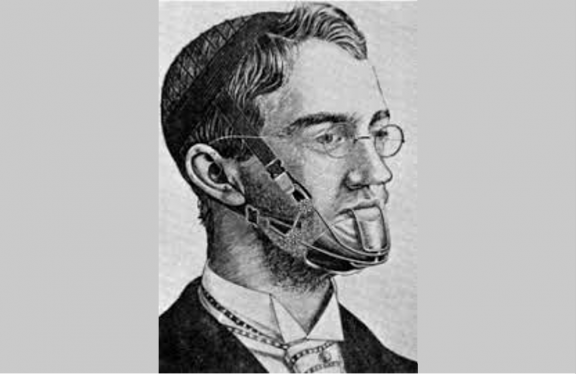From strictly aesthetics to an integral part of oral health: A brief history of orthodontics through the ages

A patient wears one of the first dental aligners, developed in the 18th century[1].
Orthodontics is one of the most technologically progressive specialities in dentistry. Over the past 100 years, a host of new orthodontic tools and methods have been developed to make treatment simpler and shorter, less painful and more discreet. Orthodontics has been leading the way in terms of powerful computing developments, including imaging and clinical applications[2].
Where it all began
While some might claim that the pursuit of straight teeth has been around since ancient times, the large-scale development of orthodontics started much later.
During the 18th and 19th century, the first systematic descriptions of regulation devices were published, including the most comprehensive Treatise on Oral Deformities as a Branch of Mechanical Surgery by Norman Kingsley in 1880[3].
Pierre Fauchard's famed Le Chirurgien Dentiste: A Treatise on the Teeth, published in 1728, introduces a dental aligner called a bandeau. This appliance was made of precious metal and was shaped like a horse shoe to align the teeth by arch expansion[4].
Fauchard's bandeau was further refined by another French dentist, Etienne Bourdet (1722-1789), who was the dentist to the king of France at the time.
In the United States in the late 1890s, the “father of modern orthodontics” Edward H. Angle defined the first clear definition of normal occlusion along with the classification of malocclusion. In 1900, he founded the Angle School of Orthodontia in St. Louis, Missouri, establishing orthodontics as a formal speciality of dentistry[5].

Edward H. Angle (1855-1930), the "father of modern orthodontics" in the United States[6].
At the turn of the 20th century, smiling was often viewed as a characteristic of the lower classes. However, significant cultural and societal changes of the 20th century led to an increase in orthodontic treatment. The Golden Age of Hollywood redefined the ideal physical appearance and a bright smile became a promise for a successful life and career. After the Second World War, textbooks began to note the importance of orthodontics in improving speech defects and reducing gum disease.
At the time, many people viewed orthodontic treatment as a cure for “inferiority complexes.” Studies also claimed that crooked teeth could have a negative impact on children’s self-esteem and increased the pressure to smile.
This was especially true for girls, who often viewed smiling as a gendered responsibility. In Putting it Straight: A Story of Crooked Teeth (1957) by the Canadian National Film Board, mouth deformities are portrayed as the defining factor of popularity. The film tells the story of poor Mary, who is only accepted by her peers once her teeth are fixed with orthodontic treatment.

Mary's teeth are inspected in Putting it Straight: A Story of Crooked Teeth (1957)[7].
As part of the shifts occurring in healthcare in the West during the 1980s, orthodontics further emphasized patients’ unique and individual needs. Orthodontics evolved to focus on the importance of a stable bite as well as facial aesthetics. Adult orthodontics became more and more common[8] due to widespread oral hygiene improvements which meant that people were more likely to keep their teeth throughout their life.
The number of female patients undergoing orthodontic treatment has almost always outnumbered male patients. In the 1990s, celebrity culture further reinforced the importance of physical appearance, especially for women.
Orthodontics today goes far beyond aesthetics
Malocclusion is not only as an aesthetic issue, but also as an important oral health matter.[9] FDI’s Policy Statement on Malocclusion in Orthodontics and Oral Health states that malocclusion may affect oral health by increasing the prevalence of dental caries, periodontitis, risk for trauma and difficulties in masticating, swallowing, breathing and speaking.
Orthodontic treatment has evolved to become an integral part of dentistry, helping to prevent oral diseases and improve quality of life.
References
[1] Orsós M. Orthodontic aspects of Emergency dentistry. [Presentation] Semmelweis University Faculty of Dentistry Department of Community Dentistry. 2018.
[2] Wang CH H, Randazzo L. Evolution of imaging and management systems in orthodontics. Am J Orthod Dentofacial Orthop. 2016;149(6): 798-805
[3] Proffit W R. Contemporary orthodontics. 3rd ed. Oxford: Elsevier LTD; 2013.
[4] Orsós M. Orthodontic aspects of Emergency dentistry. [Presentation] Semmelweis University Faculty of Dentistry Department of Community Dentistry. 2018.
[5] Proffit W R. Contemporary orthodontics. 3rd ed. Oxford: Elsevier LTD; 2013.
[6] Asbell M B. A brief history of orthodontics. Am J Orthod Dentofacial Orthop. 1990; 98(3): 206-13.
[7] Fandor. Putting it Straight. Available from: https://www.fandor.com/films/putting_it_straight [Accessed 15 July 2020].
[8] Micu M, Carstairs C. From Improving Egos to Perfecting Smiles: Orthodontics and Psychology, 1945–2000. Canadian Bulletin of Medical History. 2018;35(2): 309-336.
[9] FDI World Dental Federation. Malocclusion in Orthodontics and Oral Health. FDI. Available from: https://www.fdiworlddental.org/resources/policy-statements/malocclusion-in-orthodontics-and-oral-health [Accessed 8 July 2020].


